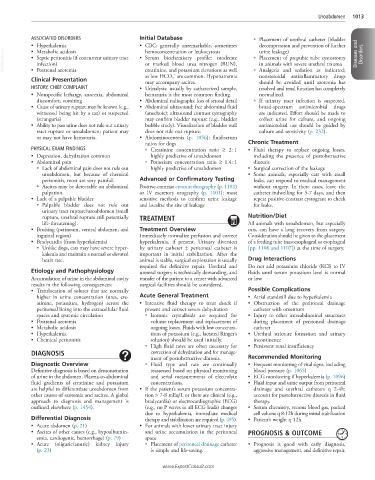Page 2027 - Cote clinical veterinary advisor dogs and cats 4th
P. 2027
Uroabdomen 1013
ASSOCIATED DISORDERS Initial Database ○ Placement of urethral catheter (bladder
• Hyperkalemia • CBC: generally unremarkable, sometimes decompression and prevention of further
VetBooks.ir • Septic peritonitis (if concurrent urinary tract • Serum biochemistry profile: moderate ○ Placement of prepubic tube cystostomy Diseases and Disorders
hemoconcentration or leukocytosis
urine leakage)
• Metabolic acidosis
in animals with severe urethral trauma
infection)
or marked blood urea nitrogen (BUN),
• Postrenal azotemia
creatinine, and potassium elevations as well
−
as low HCO 3 are common. Hyponatremia ○ Analgesia and sedation as indicated;
nonsteroidal antiinflammatory drugs
Clinical Presentation may accompany ascites. should be avoided until azotemia has
HISTORY, CHIEF COMPLAINT • Urinalysis: usually by catheterized sample, resolved and renal function has completely
• Nonspecific lethargy, anorexia, abdominal hematuria is the most common finding. normalized.
discomfort, vomiting • Abdominal radiographs: loss of serosal detail ○ If urinary tract infection is suspected,
• Cause of urinary rupture may be known (e.g., • Abdominal ultrasound: free abdominal fluid broad-spectrum antimicrobial drugs
witnessed being hit by a car) or suspected (anechoic); ultrasound contrast cystography are indicated. Effort should be made to
(stranguria) may confirm bladder rupture (e.g., bladder collect urine for culture, and ongoing
• Ability to pass urine does not rule out urinary bubble study). Visualization of bladder wall antimicrobial use should be guided by
tract rupture or uroabdomen; patient may does not rule out rupture. culture and sensitivity (p. 232).
or may not have hematuria. • Abdominocentesis (p. 1056): fluid:serum
ratios for dogs Chronic Treatment
PHYSICAL EXAM FINDINGS ○ Creatinine concentration ratio ≥ 2 : 1 • Fluid therapy to replace ongoing losses,
• Depression, dehydration common highly predictive of uroabdomen including the presence of postobstructive
• Abdominal pain ○ Potassium concentration ratio ≥ 1.4 : 1 diuresis
○ Lack of abdominal pain does not rule out highly predictive of uroabdomen • Surgical correction of the leakage
uroabdomen, but because of chemical • Some animals, especially cats with small
peritonitis, most are very painful. Advanced or Confirmatory Testing leaks, can respond to medical management
○ Ascites may be detectable on abdominal Positive-contrast cystourethrography (p. 1181) without surgery. In these cases, leave the
palpation. or IV excretory urography (p. 1101): most catheter indwelling for 5-7 days, and then
• Lack of a palpable bladder sensitive methods to confirm urine leakage repeat positive-contrast cystogram to check
○ Palpable bladder does not rule out and localize the site of leakage for leaks.
urinary tract rupture/uroabdomen (small
rupture, urethral rupture still potentially TREATMENT Nutrition/Diet
life-threatening). All animals with uroabdomen, but especially
• Bruising (perineum, ventral abdomen, and Treatment Overview cats, can have a long recovery from surgery.
inguinal region) Immediately normalize perfusion and correct Consideration should be given to the placement
• Bradycardia (from hyperkalemia) hyperkalemia, if present. Urinary diversion of a feeding tube (nasoesophageal or esophageal
○ Unlike dogs, cats may have severe hyper- by urinary catheter ± peritoneal catheter is [pp. 1106 and 1107]) at the time of surgery.
kalemia and maintain a normal or elevated important in initial stabilization. After the
heart rate. animal is stable, surgical exploration is usually Drug Interactions
required for definitive repair. Urethral and Do not add potassium chloride (KCl) to IV
Etiology and Pathophysiology ureteral surgery is technically demanding, and fluids until serum potassium level is normal
Accumulation of urine in the abdominal cavity transfer of the patient to a center with advanced or low.
results in the following consequences: surgical facilities should be considered.
• Translocation of solutes that are normally Possible Complications
higher in urine concentration (urea, cre- Acute General Treatment • Atrial standstill due to hyperkalemia
atinine, potassium, hydrogen) across the • Intensive fluid therapy to treat shock if • Obstruction of the peritoneal drainage
peritoneal lining into the extracellular fluid present and correct severe dehydration catheter with omentum
spaces and systemic circulation ○ Isotonic crystalloids are required for • Injury to other intraabdominal structures
• Postrenal azotemia volume replacement and replacement of during placement of peritoneal drainage
• Metabolic acidosis ongoing losses. Fluids with low concentra- catheter
• Hyperkalemia tions of potassium (e.g., lactated Ringer’s • Urethral stricture formation and urinary
• Chemical peritonitis solution) should be used initially. incontinence
○ High fluid rates are often necessary for • Persistent renal insufficiency
DIAGNOSIS correction of dehydration and for manage-
ment of postobstructive diuresis. Recommended Monitoring
Diagnostic Overview ○ Fluid type and rate are continually • Frequent monitoring of vital signs, including
Definitive diagnosis is based on demonstration reassessed based on physical monitoring blood pressure (p. 1065)
of urine in the abdomen. Plasma-to-abdominal and serial measurements of electrolyte • ECG monitoring if hyperkalemia (p. 1096)
fluid gradients of creatinine and potassium concentrations. • Fluid input and urine output from peritoneal
are helpful to differentiate uroabdomen from • If the patient’s serum potassium concentra- drainage and urethral catheters q 2-4h;
other causes of azotemia and ascites. A global tion > 7-8 mEq/L or there are clinical (e.g., account for postobstructive diuresis in fluid
approach to diagnosis and management is bradycardia) or electrocardiographic (ECG) therapy.
outlined elsewhere (p. 1454). (e.g., no P waves in all ECG leads) changes • Serum chemistry, venous blood gas, packed
due to hyperkalemia, immediate medical cell volume q 8-12h during initial stabilization
Differential Diagnosis therapy and stabilization are required (p. 495). • Patient’s weight q 12h
• Acute abdomen (p. 21) • For animals with lower urinary tract injury
• Ascites of other causes (e.g., hypoalbumin- and urine accumulation in the peritoneal PROGNOSIS & OUTCOME
emia, cardiogenic, hemorrhage) (p. 79) space
• Acute (oliguric/anuric) kidney injury ○ Placement of peritoneal drainage catheter • Prognosis is good with early diagnosis,
(p. 23) is simple and life-saving. aggressive management, and definitive repair.
www.ExpertConsult.com

